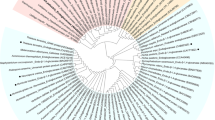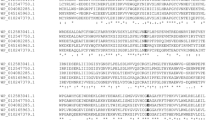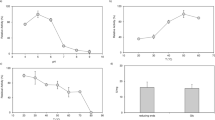Abstract
The glycoside hydrolase family 61 endoglucanase from Aspergillus kawachii (AkCel61) is a modular enzyme that consists of a catalytic domain and a carbohydrate-binding module belonging to family 1 (CBM1) that are connected by a Ser-Thr linker region longer than 100 amino acids. We expressed the recombinant AkCel61, wild-type enzyme (rAkCel61), and a truncated enzyme consisting of the catalytic domain (rAkCel61ΔCBM) in Pichia pastoris and analyzed their biochemical properties. Purified rAkCel61 and rAkCel61ΔCBM migrated on sodium dodecyl sulfate-polyacrylamide gel electrophoresis (SDS-PAGE) and were demonstrated to have apparent molecular masses of 81,000 and 34,000 Da, respectively. After treatment with endoglycosidase H, both proteins showed an increase in mobility, thus, demonstrating estimated molecular masses of 78,000 and 28,000 Da, respectively. Mass spectrometry analysis revealed that rAkCel61 and rAkCel61ΔCBM expressed in P. pastoris are heterogeneous due to protein glycosylation. The rAkCel61 protein bound to crystalline cellulose but not to arabinoxylan. The rAkCel61 and rAkCel61ΔCBM proteins produced small amounts of oligosaccharides from soluble carboxymethylcellulose. They also exhibited a slight hydrolytic activity toward laminarin. However, they showed no detectable activity toward microcrystalline cellulose, arabinoxylan, and pectin. Both recombinant enzymes also showed no detectable activity toward p-nitrophenyl β-d-glucoside, p-nitrophenyl β-d-cellobioside, and p-nitrophenyl β-d-cellotrioside.



Similar content being viewed by others
References
Armesilla A, Thurston C, Yagüe E (1994) CEL1: a novel cellulose binding protein secreted by Agaricus bisporus during growth on crystalline cellulose. FEMS Microbiol Lett 116:293–300
Bailey M, Nevalainen H (1981) Induction, isolation and testing of stable Trichoderma reesei mutants with improved production of solubilizing cellulose. Enzyme Microb Technol 3:153–157
Bauer S, Vasu P, Persson S, Mort AJ, Somerville CR (2006) Development and application of a suite of polysaccharide-degrading enzymes for analyzing plant cell-wall. Proc Natl Acad Sci USA 103:11417–11422
Benoit I, Asther M, Sulzenbacher G, Record E, Marmuse L, Parsiegla G, Gimbert I, Asther M, Bignon C (2006) Respective importance of protein folding and glycosylation in the thermal stability of recombinant feruloyl esterase A. FEBS Lett 580:5815–5821
Bolam DN, Xie H, Pell G, Hogg D, Galbraith G, Henrissat B, Gilbert HJ (2004) X4 modules represent a new family of carbohydrate-binding modules that display novel properties. J Biol Chem 279:22953–22963
Boraston AB, Warren RAJ, Kilburn DG (2001) Glycosylation by Pichia pastoris decreases the affinity of a family 2a carbohydrate-binding module from Cellulomonas fimi: a functional and mutational analysis. Biochem J 358:423–430
Chang Y, Kwon-Chung K (1998) Isolation of the third capsule-associated gene, CAP60, required for virulence in Cryptococcus neoformans. Infect Immun 66:2230–2236
Conde R, Cueva R, Pablo G, Polaina J, Larriba G (2004) A search for hyperglycosylation signals in yeast glycoproteins. J Biol Chem 279:43789–43798
Coutinho PM, Henrisaat B (1999) Carbohydrate-active enzymes: an integrated database approach. In: Gilbert HJ, Davies GJ, Henrisaat B, Svensson B (eds) Recent advances in carbohydrate bioengineering. The Royal Society of Chemistry, Cambridge, UK, pp 3–12
Ding S, Ge W, Buswell J (2006) Cloning of the multiple cellulase cDNAs from Volvariella volvacea and their differential expression during substrate colonization and fruiting. FEMS Microbiol Lett 263:207–213
Duff S, Murray W (1996) Bioconversion of forest products industry waste cellulosics to fuel ethanol: a review. Bioresource Technol 55:1–33
Foreman PK, Brown D, Dankmeyer L, Dean R, Diener S, Dunn-Coleman NS, Goedegebuur F, Houfek TD, England GJ, Kelley AS, Meerman HJ, Mitchell T, Mitchinson C, Olivares HA, Teunissen PJM, Yao J, Ward M (2003) Transcriptional regulation of biomass-degrading enzymes in the filamentous fungus Trichoderma reesei. J Biol Chem 278:31988–31997
Hara Y, Hinoki Y, Shimoi H, Ito K (2003) Cloning and sequence analysis of endoglucanase genes from an industrial fungus, Aspergillus kawachii. Biosci Biotechnol Biochem 67:2010–2013
Henrissat B, Driguez H, Viet C, Schulein M (1985) Synergism of cellulases from Trichoderma reesei in the degradation of cellulose. Bio/Technology 3:722–726
Ito K, Ogasawara H, Sugimoto T, Ishikawa T (1992) Purification and properties of acid stable xylanases from Aspergillus kawachii. Biosci Biotechnol Biochem 56:547–550
Iwashita K, Todoroki K, Kimura H, Shimoi H, Ito K (1998) Purification and characterization of extracellular and cell wall bound β-glucosidases from Aspergillus kawachii. Biosci Biotechnol Biochem 62:1938–1946
Kallas ÅM, Piens K, Denman SE, Heriksson H, Fäldt J, Johansson P, Brumer H III, Teeri TT (2005) Enzymatic properties of native and deglycosylated hybrid aspen (Populus tremula x tremuloides) xyloglucan endotransglycosylase 16A expressed in Pichia pastoris. Biochem J 390:105–113
Karlsson J, Saloheimo M, Siika-aho M, Tenkanen M, Penttilä M, Tjerneld F (2001) Homologous expression and characterization of Cel61A (EG IV) of Trichoderma reesei. Eur J Biochem 268:6498–6507
Kawai R, Igarashi K, Yoshida M, Kitaoka M, Samejima M (2006) Hydrolysis of β-1,3/1,6-glucan by glycoside hydrolase family 16 endo-1,3(4)-β-glucanase from the basidiomycete Phanerochaete chrysosporium. Appl Microbiol Biotechnol 71:898–906
Koseki T, Okuda M, Sudoh S, Kizaki Y, Iwano K, Aramaki I, Matsuzawa H (2003) Role of two α-l-arabinofuranosidases in arabinoxylan degradation and characteristics of the encoding genes from shochu koji molds, Aspergillus kawachii and Aspergillus awamori. J Biosci Bioeng 96:232–241
Koseki T, Yozo M, Mese Y, Miyanaga A, Fushinobu S, Wakagi T, Shoun H, Matsuzawa H, Hashizume K (2006) Mutational analysis of N-glycosylation recognition sites on the biochemical properties of Aspergillus kawachii α-L-arabinofuranosidase 54. Biochim Biophys Acta 1760:1458–1464
Laemmli UK (1970) Cleavage of structural proteins during the assembly of the head of bacteriophage T4. Nature 227:680–685
Lev S, Horwitz BA (2003) A mitogen-activated protein kinase pathway modulates the expression of two cellulase genes in Cochliobolus heterostrophus during plant infection. Plant Cell 15:835–844
Sakamoto S, Tamura G, Ito K, Ishikawa T, Iwano K, Nishiya N (1995) Cloning and sequencing of cellulase cDNA from Aspergillus kawachii and its expression in Saccharomyces cerevisiae. Curr Genet 27:435–439
Saloheimo A, Nakari-Setälä T, Tenkanen M, Penttilä M (1997) cDNA cloning of a Trichoderma reesei cellulose and demonstration of endoglucanase activity by expression in yeast. Eur J Biochem 249:584–591
Raguz S, Yagüe E, Wood D, Thurston C (1992) Isolation and characterization of a cellulose-growth-specific gene from Agaricus bisporus. Gene 119:183–190
Wymelenberg AV, Denman S, Dietrich D, Bassett J, Yu X, Atalla R, Predki P, Rudsander U, Teeri TT, Cullen D (2002) Transcript analysis of genes encoding a family 61 endoglucanase and a putative membrane-anchored family 9 glycosyl hydrolase from Phanerochaete chrysosporium. Appl Environ Microbiol 68:5765–5768
Author information
Authors and Affiliations
Corresponding author
Electronic supplementary material
Below is the link to the electronic supplementary material.
Supplemental figure
Multiple alignment of amino acid sequences of AkCel61 and other family 61 proteins. AkCel61, A. kawachii Cel61; ABF50850, A. nidulans AN1602.2; VvEgII, V. volvacea EgII; CAD21296, N. crassa putative endoglucanase. Identical amino acids at conserved positions are boxed in black, and the N-glycosylation recognition sites are boxed in gray (PDF 39 kb).
Rights and permissions
About this article
Cite this article
Koseki, T., Mese, Y., Fushinobu, S. et al. Biochemical characterization of a glycoside hydrolase family 61 endoglucanase from Aspergillus kawachii . Appl Microbiol Biotechnol 77, 1279–1285 (2008). https://doi.org/10.1007/s00253-007-1274-4
Received:
Revised:
Accepted:
Published:
Issue Date:
DOI: https://doi.org/10.1007/s00253-007-1274-4




